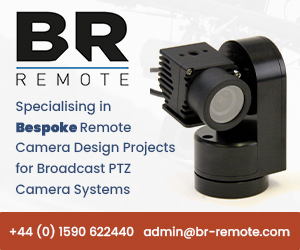Broadcast News
12/06/2015
High Ambitions For Audio Over IP

Audio Over IP has been in existence for quite some time, so it's difficult to call it a new or emerging technology, writes Pieter Schillebeeckx, Product Director, TSL Products.
Axia Audio's LiveWire system was launched in 2003, for example. For that, you have to take your hat off to them; they designed and implemented their own Precision Time Protocol (PTP) before most people had heard of such a thing.
For some reason though it's taken this long for IP to catch the imagination of many broadcasters, and now the debate is heating up.
Ambitions for Audio Over IP (AoIP) in the broadcast community are set high. Some see it as a technology of ultra-convenience, or as a magic bullet for the bloated capital budgets that come with infrastructure and capacity upgrade – a high channel count transport system that can use existing IT provision. In practice, however, these might be false headlines – distractions from an even brighter future where infrastructure flexibility with software-driven routing of audio, video and metadata, complete with all-encompassing synchronization, is actually the main prize.
Take a typical US broadcast truck set-up. MADI is still king here, not just for linking trucks and stageboxes, but for providing feeds at every production position via audio monitoring units where personnel can create their own mix.
To provide this they typically use a large video router expanded with MADI routing capability, sending out one MADI stream for eight positions, another one for the next eight, and so on. It's a little inefficient – you could pick off feeds from a single MADI loop, for example, but the central control is an important factor.
If you replace that with an AoIP network – AES 67, for example – you no longer need the 20U router; you can use a virtual patch panel on a simple App and the workflow stays the same. Reliability improves too – using multiple switches and distributor logic means that if one switch goes down, you might lose what's connected to that switch, but everything else will continue to work. If that central router goes down, you lose everything.
If you scale these gains up from a truck to a regional or national broadcast centre, then this kind of flexibility, control, and reliability, surely becomes the main incentive for making the move?
To get there though, we must be realistic about the hurdles to practical implementation of AoIP and VoIP in the broadcast environment.
First, it is most likely that a broadcaster's IP transport will require a separate, managed network, which itself has a cost. Dispensing with the central router is a goal worth striving for, but we shouldn't dismiss the network as a simple trip to the local computer store for some Cat5 and a few off-the-shelf switches. A network built and managed to tight parameters, with high enough bandwidth for audio and video, and capable of clean switching is certainly not trivial. Every point where you might have a camera really needs to have a 10Gb switch. A busy area on a network might be the video mixer on a live production, which would certainly require a 40Gb or even a 100Gb switch. This is neither commonplace nor inexpensive technology.
Audio-only is a different matter and its bandwidth requirements are tiny in comparison. A high-spec, nicely managed existing IT infrastructure with well managed Quality Of Service, VLAN, priority rules, and so on can cope with high numbers of audio channels with good reliability via 1Gb switching.
AoIP and VoIP are correctly termed layer 3 technologies, but maybe the requirement for specific network hardware and management challenges this in spirit and brings it into the realm of a layer 2 protocol like AVB?
This leads to the second hurdle; all of this comes with the training and knowledge requirement that up until now has not been prevalent in the broadcast department. Staff will have to become fluent in IT, and comfortable with IT infrastructure. Some are already there, but many are not.
Today's reality is that most implementations of Audio Over IP are straight replacements for an existing technology such as MADI or SDI. Yes, there are advantages such as using metadata for remote control of mic pres, for example, but the broadcaster's content-over-IP ideal – where audio and video share the same, synchronised, software-managed transport – while certainly on the horizon, is still in its infancy.
Technologies such as SMPTE ST 2059 – a SMPTE profile for the IEEE 1588 PTP, for example, could give the various AoIP and VoIP protocols a common sync-base that will be a significant enabler for synchronised IP content.
Audio and video over IP for broadcast is not really about cost. We don't think implementation of IP-based infrastructure will be significantly cheaper. However, a convincing argument can be made on significant and very practical gains.
At TSL, we're ready. We are already bringing our detailed knowledge and practical experience of AoIP to bear in existing installations. We are embracing the future and working on next generation audio and video monitoring products to support all flavours of audio and video over IP.
This approach, I believe, is the only way that manufacturers, integrators, and broadcasters alike will realise their IP ambitions.
This article is also available to read at BFV online.
(JP)
Axia Audio's LiveWire system was launched in 2003, for example. For that, you have to take your hat off to them; they designed and implemented their own Precision Time Protocol (PTP) before most people had heard of such a thing.
For some reason though it's taken this long for IP to catch the imagination of many broadcasters, and now the debate is heating up.
Ambitions for Audio Over IP (AoIP) in the broadcast community are set high. Some see it as a technology of ultra-convenience, or as a magic bullet for the bloated capital budgets that come with infrastructure and capacity upgrade – a high channel count transport system that can use existing IT provision. In practice, however, these might be false headlines – distractions from an even brighter future where infrastructure flexibility with software-driven routing of audio, video and metadata, complete with all-encompassing synchronization, is actually the main prize.
Take a typical US broadcast truck set-up. MADI is still king here, not just for linking trucks and stageboxes, but for providing feeds at every production position via audio monitoring units where personnel can create their own mix.
To provide this they typically use a large video router expanded with MADI routing capability, sending out one MADI stream for eight positions, another one for the next eight, and so on. It's a little inefficient – you could pick off feeds from a single MADI loop, for example, but the central control is an important factor.
If you replace that with an AoIP network – AES 67, for example – you no longer need the 20U router; you can use a virtual patch panel on a simple App and the workflow stays the same. Reliability improves too – using multiple switches and distributor logic means that if one switch goes down, you might lose what's connected to that switch, but everything else will continue to work. If that central router goes down, you lose everything.
If you scale these gains up from a truck to a regional or national broadcast centre, then this kind of flexibility, control, and reliability, surely becomes the main incentive for making the move?
To get there though, we must be realistic about the hurdles to practical implementation of AoIP and VoIP in the broadcast environment.
First, it is most likely that a broadcaster's IP transport will require a separate, managed network, which itself has a cost. Dispensing with the central router is a goal worth striving for, but we shouldn't dismiss the network as a simple trip to the local computer store for some Cat5 and a few off-the-shelf switches. A network built and managed to tight parameters, with high enough bandwidth for audio and video, and capable of clean switching is certainly not trivial. Every point where you might have a camera really needs to have a 10Gb switch. A busy area on a network might be the video mixer on a live production, which would certainly require a 40Gb or even a 100Gb switch. This is neither commonplace nor inexpensive technology.
Audio-only is a different matter and its bandwidth requirements are tiny in comparison. A high-spec, nicely managed existing IT infrastructure with well managed Quality Of Service, VLAN, priority rules, and so on can cope with high numbers of audio channels with good reliability via 1Gb switching.
AoIP and VoIP are correctly termed layer 3 technologies, but maybe the requirement for specific network hardware and management challenges this in spirit and brings it into the realm of a layer 2 protocol like AVB?
This leads to the second hurdle; all of this comes with the training and knowledge requirement that up until now has not been prevalent in the broadcast department. Staff will have to become fluent in IT, and comfortable with IT infrastructure. Some are already there, but many are not.
Today's reality is that most implementations of Audio Over IP are straight replacements for an existing technology such as MADI or SDI. Yes, there are advantages such as using metadata for remote control of mic pres, for example, but the broadcaster's content-over-IP ideal – where audio and video share the same, synchronised, software-managed transport – while certainly on the horizon, is still in its infancy.
Technologies such as SMPTE ST 2059 – a SMPTE profile for the IEEE 1588 PTP, for example, could give the various AoIP and VoIP protocols a common sync-base that will be a significant enabler for synchronised IP content.
Audio and video over IP for broadcast is not really about cost. We don't think implementation of IP-based infrastructure will be significantly cheaper. However, a convincing argument can be made on significant and very practical gains.
At TSL, we're ready. We are already bringing our detailed knowledge and practical experience of AoIP to bear in existing installations. We are embracing the future and working on next generation audio and video monitoring products to support all flavours of audio and video over IP.
This approach, I believe, is the only way that manufacturers, integrators, and broadcasters alike will realise their IP ambitions.
This article is also available to read at BFV online.
(JP)
Top Related Stories
Click here for the latest broadcast news stories.
11/11/2016
What Is The Future For Immersive Audio?
Peter Poers, Managing Director at Jünger Audio, looks at production efforts versus consumer experience. Introduction Along with the evolution of highe
What Is The Future For Immersive Audio?
Peter Poers, Managing Director at Jünger Audio, looks at production efforts versus consumer experience. Introduction Along with the evolution of highe
18/03/2014
Digigram Announces NAB Lineup
At this year's NAB Show, Digigram is to feature a complete range of products designed to "address the requirements of all applications and budgets". T
Digigram Announces NAB Lineup
At this year's NAB Show, Digigram is to feature a complete range of products designed to "address the requirements of all applications and budgets". T
06/05/2014
Digigram at BroadcastAsia2014
At BroadcastAsia2014, Digigram has announced it will feature "a complete range of products designed to address the requirements of all applications an
Digigram at BroadcastAsia2014
At BroadcastAsia2014, Digigram has announced it will feature "a complete range of products designed to address the requirements of all applications an
20/07/2017
CallMe Provides Broadcasters With Easy-To-Use Audio Over IP
CallMe is a cloud-based communications platform for audio codecs which handles all the complicated stuff and provides the user with a simple click-and
CallMe Provides Broadcasters With Easy-To-Use Audio Over IP
CallMe is a cloud-based communications platform for audio codecs which handles all the complicated stuff and provides the user with a simple click-and
20/08/2015
GatesAir Adds To IP Portfolio
GatesAir is to demonstrate its latest IP connectivity innovations for radio broadcasters to IBC2015, Stand 8.B20. With new products and applications f
GatesAir Adds To IP Portfolio
GatesAir is to demonstrate its latest IP connectivity innovations for radio broadcasters to IBC2015, Stand 8.B20. With new products and applications f
24/08/2010
APT Launch New IP Audio Silver At IBC
APT, the audio codec specialists within the WorldCast Systems Group will launch the IP Audio Silver for cost-effective audio to IP conversion at this
APT Launch New IP Audio Silver At IBC
APT, the audio codec specialists within the WorldCast Systems Group will launch the IP Audio Silver for cost-effective audio to IP conversion at this
09/08/2012
Blackmagic Design Announces Major New Software Update
Blackmagic Design has announced a major new software update that adds full-audio mixing capability to its ATEM 1 M/E Production Switcher and ATEM Tele
Blackmagic Design Announces Major New Software Update
Blackmagic Design has announced a major new software update that adds full-audio mixing capability to its ATEM 1 M/E Production Switcher and ATEM Tele
05/12/2025
DHD Audio Unveils Advances Latest Audio Production Advances
DHD audio, a leading provider of broadcast-quality audio production, post-production, and routing equipment, has reported a highly successful 2025 mar
DHD Audio Unveils Advances Latest Audio Production Advances
DHD audio, a leading provider of broadcast-quality audio production, post-production, and routing equipment, has reported a highly successful 2025 mar
10/06/2025
Stage Audio Works Integrates Audio System At The Namibia Padel Club
Stage Audio Works (SAW) Namibia recently completed the integration of a professional audio system at the newly launched Namibia Padel Club in Swakopmu
Stage Audio Works Integrates Audio System At The Namibia Padel Club
Stage Audio Works (SAW) Namibia recently completed the integration of a professional audio system at the newly launched Namibia Padel Club in Swakopmu
23/04/2025
Martin Audio Appoints Luxury Supply Audio & Lighting
Martin Audio has announced Luxury Supply Audio & Lighting, one of Cambodia's leading professional audio and lighting resellers, as its new regional di
Martin Audio Appoints Luxury Supply Audio & Lighting
Martin Audio has announced Luxury Supply Audio & Lighting, one of Cambodia's leading professional audio and lighting resellers, as its new regional di
17/01/2025
Audio-Technica Expands Its UK Commercial Audio Sales Team
Audio-Technica has recently expanded its UK Commercial Audio sales team with two new appointments, Craig Higgins and Sonny Sloggett, reflecting the co
Audio-Technica Expands Its UK Commercial Audio Sales Team
Audio-Technica has recently expanded its UK Commercial Audio sales team with two new appointments, Craig Higgins and Sonny Sloggett, reflecting the co
18/11/2024
W E Audio Invests In Martin Audio WPL
Long-term Martin Audio rental partner, W E Audio, recently underlined its commitment to the British manufacturer, by making a massive investment acros
W E Audio Invests In Martin Audio WPL
Long-term Martin Audio rental partner, W E Audio, recently underlined its commitment to the British manufacturer, by making a massive investment acros
20/02/2024
NADiV Audio Introduces Range Of Dante Audio And Control Devices
NADiV Audio has launched its NADiV range of Dante-enabled audio interface and control devices for portable and installed AV and pro audio environments
NADiV Audio Introduces Range Of Dante Audio And Control Devices
NADiV Audio has launched its NADiV range of Dante-enabled audio interface and control devices for portable and installed AV and pro audio environments
28/07/2023
DHD audio Unveils XS3 Core Audio Processor
DHD audio has announced a new addition to its modular range of audio studio equipment and systems. The XS3 core audio processor supports up to 20 ster
DHD audio Unveils XS3 Core Audio Processor
DHD audio has announced a new addition to its modular range of audio studio equipment and systems. The XS3 core audio processor supports up to 20 ster
17/07/2023
ES-Pro Audio Appointed To Handle Prism Sound's Range Of Audio Converters
Prism Sound has appointed ES-Pro Audio to handle its entire range of audio converters to the professional market in Germany. Formerly a Prism Sound re
ES-Pro Audio Appointed To Handle Prism Sound's Range Of Audio Converters
Prism Sound has appointed ES-Pro Audio to handle its entire range of audio converters to the professional market in Germany. Formerly a Prism Sound re















